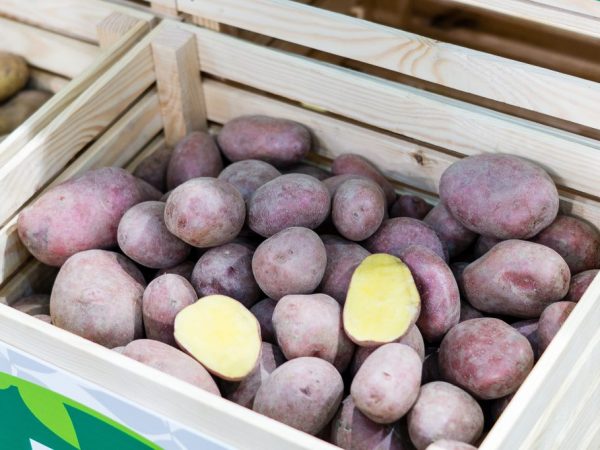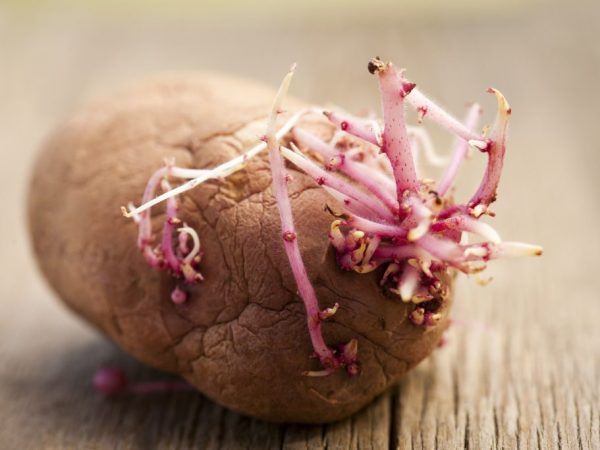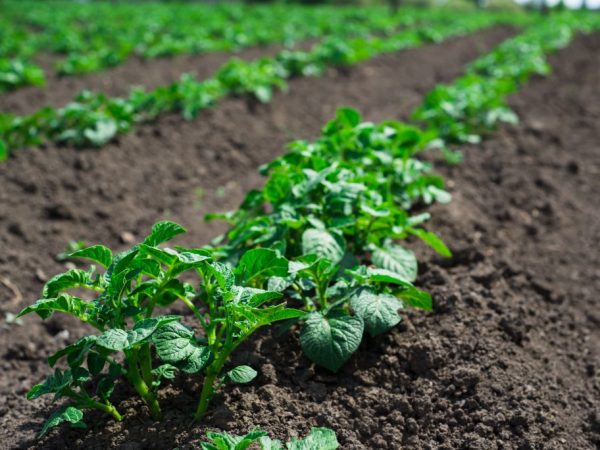Characteristics of cornflower potatoes
Those who have planted the cornflower variety at least once will appreciate it. It stands out favorably against the background of other representatives of culture. The vegetable has excellent varietal characteristics, and also boasts an unusual fruit appearance.

Characteristics of cornflower potatoes
the variety is very productive. It is this feature that makes him a favorite guest on the backyard beds.
Features of the variety
Cornflower potato description, which is in many ways similar to the popular Soviet varieties Tsyganka and Sineglazka. Root crops with an unusual color grow well throughout Russia, with the exception of its northern regions.
The variety is also unique for its extraordinarily beautiful bush. Large dark green leaves grow densely on strong erect stems. During the flowering period, the tops of the shoots are crowned with a scattering of purple flowers.
Advantages and disadvantages
The characteristics of cornflower potatoes include both positive and negative aspects.
There are much more pluses, so this variety can be recommended for growing and getting a bountiful harvest.
Vasily potatoes have the following advantages:
- The variety is medium early, therefore its tubers are much larger than that of the early one.
- Potatoes are ready for harvesting 65-70 days after the first shoots appear.
- The color of the tuber shell is very decorative, although it is lost during heat treatment.
- The tubers contain more vitamin C than half a lemon. Among other things, it contains carotenoids. These substances act as antioxidants and prevent the formation of free radicals.
- The bush is compact and erect and requires less hilling.
- High yield, as well as the ability to resist nightshade cancer.
- Vasily potatoes are used to prepare first and second courses. When boiled, tubers crack, but do not become crumbly. This is due to the high content of starch in the vegetable.
It is worth noting the disadvantages that the gardener will have to face:
- Lack of immunity to pathogens of dry and ring rot;
- Susceptible to cyst-forming aureus nematode;
- The tuber germinates quickly, thanks to the "eyes" located on the very surface of the skin, which makes it difficult to store it in winter.
- On acidified soil, the vegetable gives meager yields of very small tubers, which are often affected by scab.
Despite all the shortcomings of the description of the potato variety, Cornflower, it has very good reviews among gardeners. And in order to get high-quality tubers, it must be fertilized, hilled and watered.
Planting potatoes

Before planting, the tubers must be germinated.
In order for the planting material to be well preserved, it is recommended to keep it in a cool, dark room in winter. A dry basement or storage room is ideal.
In mid-February, the tubers are taken out and placed in one layer for germination.The potatoes are sprinkled with sawdust on top and constantly moistened with a spray bottle.
Soil preparation
The place for the beds must be thought out in advance, taking into account the crop rotation. Rotted manure or humus is introduced into the ground. The soil itself is dug to the depth of one bayonet, leaving large lumps unbroken. This is done for pest control.
You can also sow the area with rye, wheat, mustard, rape, etc. These plants play the role of green manure and enrich the soil with organic matter. As soon as the young greenery reaches 10 cm, the plants are mowed, or the area is completely dug up along with the sidirates. In the spring, the digging is repeated, and complex fertilizers, humus or bird droppings are introduced into the soil.
Planting potatoes
After the danger of the return of night frosts has passed, the potato tubers are planted in open ground. Before this, chemical fertilizers, chicken or cow droppings, which have managed to rot, are placed in the holes or trenches. Ash can also be used as a source of trace elements.
Sprouted tubers must be examined and planted with buds upward. This will speed up the germination process. Some summer residents practice planting only parts of the tubers or even cleaning them. The planting depth will depend on the density of the soil. The lighter it is, the deeper the vegetable can be planted.
Potato care
Potato variety Cornflower, whose characteristic describes it as universal, requires growing on fertile soil. Top dressing, timely watering and treatment from parasites significantly affect the yield and its quality.

Weeding is important for plants
It is also important to remove weeds by weeding or mulching. Do not use pine needles as mulch, because it strongly acidifies the soil. For the entire growing season, the bushes are spud at least 3 times. The procedure is repeated until there is a gap between the hills.
Watering
From the moment the first shoots appear until the beginning of flowering, it makes no sense to water the plantings, except in very dry and hot weather. When the plant begins to bloom, tubers begin to form on the roots. At this time, the entire production depends on the moisture content of the soil.
Watering is carried out in this way:
- water is poured at the root, and not on top of the tops;
- after watering, the soil is loosened, thereby improving aeration;
- the bushes huddle, shoveling the earth onto the stems.
Water the plant mainly in the evening or in cloudy weather. It is not recommended to use sprinklers for these purposes, because the ingress of moisture on the tops can provoke the development of late blight.
Fertilizer
To obtain maximum crop productivity, fertilizing is necessary. Fertilization starts just before flowering. The soil is well moistened before this, so that it is easier for the bush to absorb nutrients from it.
As a top dressing they use:
- chicken droppings soaked in water for 2 weeks in a ratio of 1:10;
- 1 tbsp. l of urea diluted in 10 l of water, at the rate of 400-500 ml for each plant;
- soaked varietal herb prepared by fermentation;
- infused manure at the rate of 1:10 with water.
All these fertilizers are applied at the root. The interval between dressings should be at least 1-1.5 weeks.
Pest control
In order to protect tubers and tops from pests, it is recommended to treat the planting material with special preparations before planting. To do this, the tubers are soaked in a solution or sprayed with it. If the preparation is used in dry form, then it is mixed with sifted wood ash and powdered using the same sieve.
If there was no spring treatment for pests, then an adult plant will need to be sprayed. This is ineffective, since the chemical is quickly washed off from the shoots by sediments.
Conclusion
The Cornflower variety should be planted for the unusual appearance of the fruits and their excellent taste characteristics. The vegetable is equally well suited for boiling, frying, and mashed potatoes.
With proper care, the plant produces good yields. From one hundred square meters, you can get up to 70 kg of large healthy fruits. The main thing is to follow the rules of crop rotation and not plant it after other nightshades.

